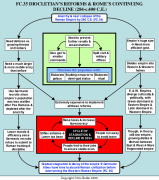FC35: Diocletian's reforms & the later Roman Empire (284-395)
Flowchart
When Diocletian took the throne in 284, he found an empire in shambles from 50 years of civil wars, invasions, and plague. The population was decimated and demoralized. Many of the peasants had become serfs tied to the soil for local lords in return for protection. Large sections of the empire's agriculture and trade were wrecked. The coinage was debased to the point of being almost worthless. The frontiers were under constant pressure. And the army was in serious need of reforms. Everywhere he looked Diocletian saw serious problems, while the means to solve those problems were horribly damaged. Therefore, he concentrated on three issues: defense, creating a more efficient government, and protecting the emperor against revolts and assassination.
Turning to the army, Diocletian saw two needs that worked against each other: the need for efficient defense against the growing threats on his frontiers, and the need for insurance against revolts. The larger the army he created, the more potential there was for revolt. But too small an army meant invasions, which was even worse. Therefore, he increased the army to twice its size under Augustus. And since there were now simultaneous threats on several frontiers, Diocletian also split this army into two parts: stationary frontier militia who could stop small invasions and slow down big ones, and mobile legions, increasingly made of cavalry, that could rush to any trouble spots that the militia could not handle.
Unfortunately, the Roman populace, unused to military service after the Pax Romana and reduced in numbers by the recent anarchy, could not provide the number and quality of recruits that were needed. As a result, the government resorted more and more to recruiting Germanic tribesmen who were willing to fight for Rome for a price. While these recruits were warlike enough, they were generally unwilling to submit to the level of discipline and training that had made the Roman army so effective through the centuries. As a result, the Roman army, especially in the West where roughly half the recruits were Germanic, decayed to a pathetic shell of its former greatness.
However, this larger army further increased the danger of revolts by powerful generals. Diocletian did three things to protect himself against this. First, he broke the army into smaller commands for each general, while keeping part of the mobile legions under his personal command. Second, he split the control of each province between civil and military authorities. This made it harder for a rebellious general to command such resources as food and money needed for a successful revolt. However, it also meant that civil governors and generals might not cooperate against invasions. Finally, Diocletian isolated himself with elaborate court ritual similar to that of the Persians. Not only did this physically separate him from potential assassins, it also gave him a semi-divine status that made attacking the emperor seem like a sacrilege.
Finally, the empire needed a more efficient government than it had had in the calmer days of the Pax Romana. For one thing, the empire was much too large for one emperor to defend, especially now that several frontiers would come under attack at the same time. Therefore, Diocletian split the empire between the Latin speaking West and the Greek speaking East, with an emperor, known as an Augustus, and separate administration in each half. Technically, there was still one Roman Empire, but more and more it functioned as two independent and, at times, competing empires. Overall, splitting the empire aggravated the natural split between Greek East and Latin West and prevented cooperation when it was most needed.
Unfortunately, a larger army, bureaucracy, and elaborate court required heavy taxes. This merely stifled people's initiative to work hard. In order to ensure a stable tax base, people and their descendants were tied to their stations in life. Not only did a shoemaker, soldier, or farmer have to remain in his profession for life, but his sons had to follow in his footsteps, as did their sons after them and so on. This plus the high taxes reduced people's incentive to work hard and helped create a stagnant economy. The depressed economy meant a lower tax base to draw taxes from, which forced the government to further raise taxes, thus catching Roman society in a vicious feedback cycle similar to the one that triggered the anarchy of the third century.
The Roman Empire under Diocletian presents a depressing picture, with its frontiers under constant pressure, oppressive taxes, and people stuck in their positions in society. However, it was more secure from invasion, which did allow trade and agriculture to revive some. One might doubt whether Roman security was worth the price paid for it. However, Diocletian did accomplish one thing of importance for later civilization. He propped the Roman Empire back up for two more centuries, allowing the new tribes along the northern frontiers to become more accustomed to Roman civilization through trade, raiding its borders, and serving as mercenaries in its army. When the western half of the empire finally fell by 500 C.E., these tribes were more willing to try to preserve Roman civilization and pass its heritage on to the Middle Ages and eventually to our own culture.


